Morphological types show striking differences between various environments. If we tabulate the percentages of various galaxy types in rich and poor clusters and in the "field", a clear distinction emerges:
| Type: | cD | E+S0 | S+I |
| Rich clusters | 93 | 56 | 38 |
| Poor clusters | 6 | 20 | 14 |
| Field" | < 6 | < 24 | 48 |
E and S0 galaxies favor rich environments, and cD systems even more so. This is sometimes expressed in terms of spiral fraction, evaluated for lots of clusters but somewhat subjective when determined only from Sky Survey material. It has long been known as well that spirals and irregulars favor clusters of irregular (rather than centrally concentrated) form, but this is likely to reflect a nearly universal relation between morphology and local galaxy density (see Dressler 1980 ApJ 236, 351). His figures 4 and 5 (courtesy of the AAS) illustrate the dependence on local density rather than distance from the cluster core as being more universal:
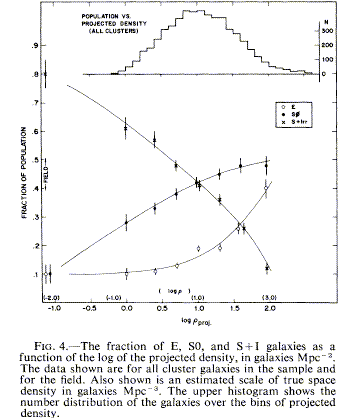

One frequently finds this relation within a single cluster, with galaxies in the core being only E/S0. Consideration of the strong possibility that different clustering scales and densities grow at different rates complicates the heredity - versus - environment issue here, in that freezing the (proto)galaxy population at some early epoch, in itself, won't give the observed correlations.
There are several possibilities for this, mostly concerned with getting rid of gas-rich spirals. Perhaps (1) spiral galaxies couldn't form in protoclusters. This has trouble if many clusters are just now collapsing out of the Hubble flow. (2) Spirals could turn into S0s if they are stripped either by direct collisions or by ram pressure of the intracluster gas, including in both cases "galaxy harassment" (Moore et al. 1996 Nature 379, 613). (3) Spirals could turn into elliptical galaxies via mergers. In all these cases, the properties of S0s may be crucial - do they have distributions of luminosity and disk/bulge light that are consistent with origins as spirals? Their photometric properties are not consistent with simple expectations in these cases, that is with preserving the disk/bulge ratio and disk geometry (Burstein 1979: ApJ Suppl 41,435; ApJ 234, 435, 234, 829, Dressler 1980). This may mean that S0s really aren't closely related to spirals, or it more likely means that (1) the simple expectations aren't realistic enough and (2) that S0s are not a homogeneous class (as van den Bergh has argued). For example, if the disk of an S0 is heated during removal of the gas, a thicker disk will result than the original spiral had. This is unavoidable if the gas contributes significantly to the disk mass density, because the local mass density controls the vertical extent of a stellar disk for a given velocity dispersion. The connection gives the classical Oort limit (discussed, for example, in Binney and Tremaine p. 199). Thus, either a direct collision between gas-rich galaxies or ram-pressure stripping (see below) could puff up an initially thin disk. Furthermore, one may build a bulge by absorption of small gas-rich companions and successive starbursts, which might have once been easier in protoclusters (Norman 1987, Starbursts and Galaxy Evolution, Moriond meeting, p. 483). Finally, a stripped spiral disk will fade with time, initially faster than the bulge since it contains more massive stars, so that the disk/bulge ratio will decrease with time. The major problem then is that many S0s have bulges that are suspiciously bright compared to spirals. So how many kinds of S0 are there?
Gas deficiency has been inferred from H I measurements for spirals in clusters. Many results are summarized by Haynes, Giovanelli, and Chincarini 1984 (Ann Rev A&A 22, 445). In a global sense, one may define a (statistical) H I deficiency factor given an average for "normal" galaxies of the same morphological type < M >, such that for observed mass M the deficiency is (M-< M >)/< M > = 1 - M/< M >, occasionally given in logarithmic form. As shown in their Fig. 3 (from NED/Level 5), the most deficient spirals are found in cluster cores; here rA denotes the Abell radius for clusters, about 1.6 Mpc for a Virgo distance of 16 Mpc.
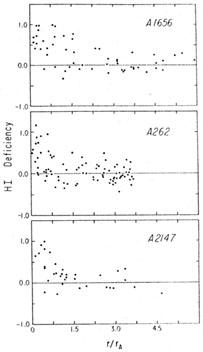
This suggests removal of the gas for those galaxies that come close to the dense core. A further suggestive correlation exists between the fraction of H I - deficient galaxies in a cluster and its hot gas content, measured through its X-ray luminosity (Giovanelli and Haynes 1985 ApJ 292, 404, reproduced courtesy of the AAS):
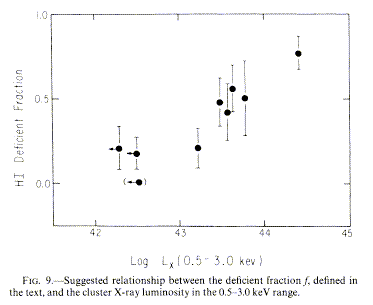
There is some ambiguity here as to whether this relation is necessarily telling us about the rate of stripping, since there is a strong correlation between overall cluster richness and Lx.
Such global results do not tell how gas is removed, or whether all kinds of ISM are equally vulnerable. A spectacular result was obtained by Cayatte et al. 1990 (AJ 100, 604), who mapped the whole Virgo Cluster core in H I - it is the outer disks that are missing in stripped spirals. Their whole cluster map is shown here, where each galaxy has been magnified 5 times for ease of comparison (courtesy AAS):
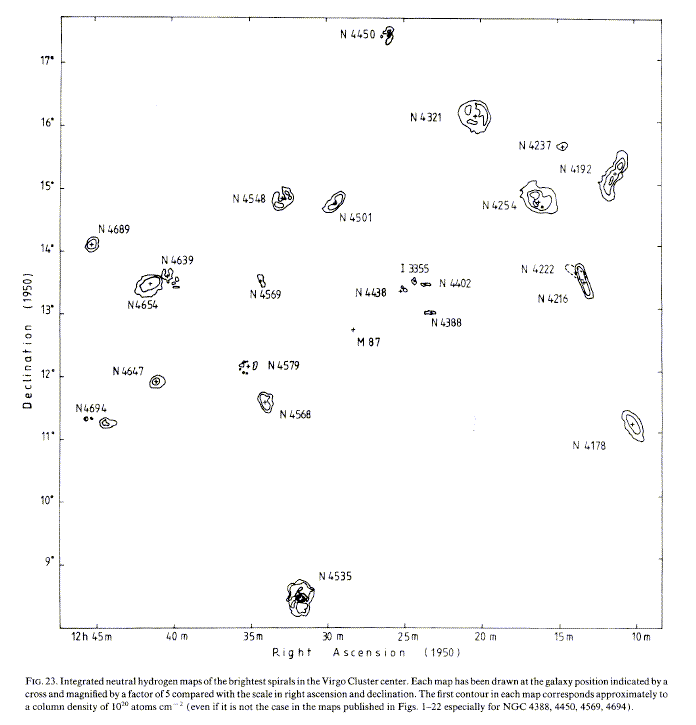
Chung et al. have produced a higher-quality version, with wider coverage as well:

This strongly suggests a dominant role for ram-pressure stripping rather than collisions, since the ram pressure rv2/2 (perhaps amplified by turbulence at the ISM-IGM interface) varies with location in the cluster. They do note that some stripped galaxies do seem to be undergoing tidal encounters, so that ram pressure isn't necessarily the whole story. One may also look for galaxies that are in the act of being stripped - galaxies in which we can see the gas being removed by no visible cause, so that direct tidal effects are ruled out (except for the tidal shock of the overall cluster field if the galaxy suddenly plunges into it, and that would affect stars and gas together). One such candidate is NGC 3312 in the Hydra I cluster (Abell 1060). As noted by Gallagher 1978 (ApJ 223, 386), this giant spiral shows diffuse matter that appears to be streaming away from part of the disk, and is projected quite close to the center of the cluster. NGC 2276 and NGC 1961 were once good candidates, but more detailed work showed that their oddities look more like weak tidal disturbances (in particular the stars and gas share the same disk geometry). Perhaps more convincing is the bizarre H I distribution in NGC 4438 (see Cayatte et al.), but a strong tidal encounter is also involved here so that the interpretation is not so clear-cut. Looking at nearby spirals claimed to show evidence for stripping, one usually finds that tidal effects are at least as likely to be involved, although the combination might make stripping work in places that it couldn't happen by itself.
The most convincing evidence for ongoing ram-pressure effects has come in the form of soft X-ray and optical emission-line trails from galaxies moving rapidly through dense clusters. Two such are known in Abell 1367. At higher redshift, I'll point to the galaxy C153 in Abell 2125 (which was already shown but not marked below). (More information on C153).

The denser molecular clouds are evidently less fragile than H I clouds. Stark et al. (1986, ApJ 310, 660) and Kenney and Young (1989, ApJ 344, 171) showed that the level of CO deficiency is less than H I deficiency; that is, H I -deficient galaxies are not as CO (which is to say H2) deficient. This would result from tidal encounters as well as stripping, since the H I disks frequently are more extensive than CO disks and thus less strongly bound. Some galaxies show spectacular H I plumes while their optical images and CO distributions are not very disturbed (such as NGC 3628, Haynes et al. 1987 ApJ 229, 83; Young et al. 1983 ApJ 269, 136).
The onset of stripping might lead to interesting effects on star formation and the state of remaining gas. Compression of clouds might occur initially, so that a galaxy just being stripped might undergo excess star formation. This has been invoked to account for the Butcher-Oemler effect, in which certain clusters at redshift z=0.1-0.5 have more blue galaxies than nearby ones. Such an effect might be expected as one form of externally driven galaxy evolution. The original report was in Butcher and Oemler 1978 (ApJ 219, 18). Their Fig. 13 (courtesy of the AAS) illustrates the excess of blue galaxies:

Later studies have confirmed the prevalence of such populations in clusters at modest redshift (for example, Dressler et al. 1985, ApJ 288, 481) though there is some evidence that the blue galaxies are frequently in tight, perhaps interacting clumps (Lavery and Henry 1988 ApJ 330, 596). HST imaging (e.g. Oemler et al. 1997 ApJ 474, 561) make it clear that many of the anomalous blue galaxies are respectably normal spirals, with these clusters being quite rich in spirals. While some mergers and tidal interactions are seen, they cannot be the whole story, so these data make it clear that in clusters, we are dealing with the wholesale transformation of spirals into E/S0 systems within the last few 109 years. Study of a cluster at z=0.83 by van Dokkum et al. (2000 ApJ 541, 95) adds the interesting wrinkle that the merger remnants which may by now have formed ellipticals can be distinguished in color, and that the fraction of spirals has reached 39% (not found for any rich cluster in our neighborhood).
The Butcher-Oemler effect is not solely redshift dependent, although it is nearly universal at z ~ 0.4. There are a few very rich clusters of red galaxies at about z=0.4 (Cl 0024+1654, for example, Schneider, Dressler, & Gunn 1989 AJ 92, 523), and rich clusters like Abell 2125 at z=0.25 (an HST detail of part of this cluster is shown below) which are unusually rich in spiral members, so that the density history of a cluster may be more important than redshift per se. If so, we see the effect because what we consider typical clusters don't span an enormous range in the rate at which spirals are transformed. There is a pretty clear selection effect involved in tracing this phenomenon, related to the Scott effect, such that at higher redshift we sample systematically richer (and more X-ray luminous) clusters (Andreon & Ettori 1999 ApJ 516, 647, though I wouldn't agree with all their conclusions).
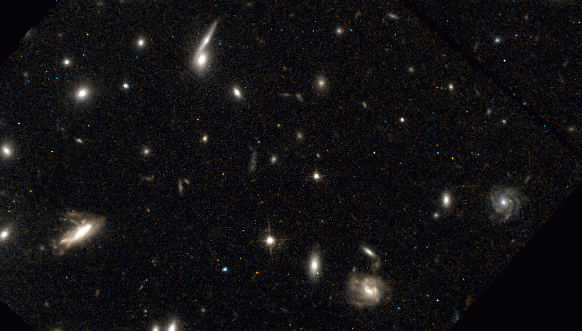
Such cases as A2125-C153 can suggest a sequence of events associated with strong stripping episodes. Initially, the major effect may be compression of the ISM (and possibly global magnetic field as well), leading to an increase in the rate of star formation. Eventually, enough gas leaves the system to cause a drop in SFR. Detailed modelling shows that this loss will be very episodic, depending on the spin/cluster orbit geometry as well as internal instabilities (see animations from Bernd Vollmer). Eventually one expects something like an S0. A surprise has been the high temperature of the departing gas, at least in part heated by conduction from the surrounding intracluster gas. Can star formation continue for lonh in this environment? Maybe...
Gas deficiency has been used to address the physical reality of compact groups of galaxies (about which more when we discuss interactions), which have sometimes been considered to be only projected or transient configurations. Williams and Rood (1987 ApJ Suppl 63, 265) have shown that for the Hickson groups, the constituent galaxies are H I deficient by a factor 2 compared to those in the more conventional groups of similar morphological type mix - that is, there is a real puzzle here.
Tidal truncation should cut off the stellar distribution of galaxies in rich environments, through either 2-galaxy encounters or encounters with the cluster potential as a whole. This effect seems to be found in companions of bright galaxies, but its role in clusters is unknown. A more interesting application is whether stripping of dark halos occurs; if so, we have a clue to how concentrated halo material is, and the possibility that cluster members may end up halo-deficient with most of the halo matter associated with the whole cluster rather than with individual galaxies. Rubin, Whitmore, and Ford (1988 ApJ 333, 522) and Whitmore, Forbes, and Rubin (1988 ApJ 333, 542) have found evidence that the rotation curves in the outer regions of cluster spirals are gently declining rather than flat as in field spirals, perhaps to be interpreted as smaller relative halo mass in cluster galaxies. In principle, this might mean that halos never became that big for cluster members, or that interactions between halos and halos or the overall cluster potential can strip some of the halo material. They find that this effect is strongest for galaxies projected in the cluster cores. A major caveat is that weak tidal encounters may be frequent enough that a cluster spiral is never really in dynamical equilibrium; certainly one can find any kind of rotation-curve shape among interacting spirals without believing this tells anything about the shapes of their potentials. This is one of the notions behind the idea that galaxy harassment - multiple, even weak, tidal encounters occurring faster than the equilibration time of the galaxies - may be important in stripping and transforming disk galaxies in clusters. Ben Moore has a movie of a harassment simulation available.
The overall effect of tidal stripping of stars has been sought in the form of diffuse cluster light, not associated with any single galaxy, which is a tough observational challenge. A remarkable step here was the discovery by Ferguson et al. (1998 Nature 391, 461) of an intergalactic population of red giants in the Virgo cluster, giving a direct measure of the density of intergalactic stars (which have, in only a few instances, been previously traced by supernovae). This was complemented by the ground-based detection of planetary nebulae in the Virgo cluster (Feldmeier, Ciardullo, & Jacoby 1998 ApJ 503, 109). The fraction of stars implied not to belong to individual galaxies is nontrivial, of order 1/3 the total in the cluster. Similar fractions, 0.1-0.25 of the starlight, have come from analyzing intracluster light after very careful accounting for the light of galaxy outskirts and control of reflections within the telescope. See, for example, these colloquium slides from Chris Mihos. This population of loose stars can trace the recent dynamical history of the cluster.
In contrast to the evidence above for spirals, elliptical galaxies, once produced, show little environmental influence. Their colors show a strikingly consistent color-absolute magnitude relation which is well accounted for just by metallicity changes, allowing very little (in fact, suspiciously little) recent star formation. Looking for these telltale signs of recent star formation in just-formed ellipticals in clusters is a popular sport; one often concentrates on spectral features such as Hd, as the last strong absorption line to disappear as a young population ages and fades. Somewhat younger systems, soon after cessation of star formation presumed to accompany gas removal, are the "E+A" systems, spectroscopically resembling a mix of E galaxy and A-star spectra.
Last changes: 9/2006 © 2000-6